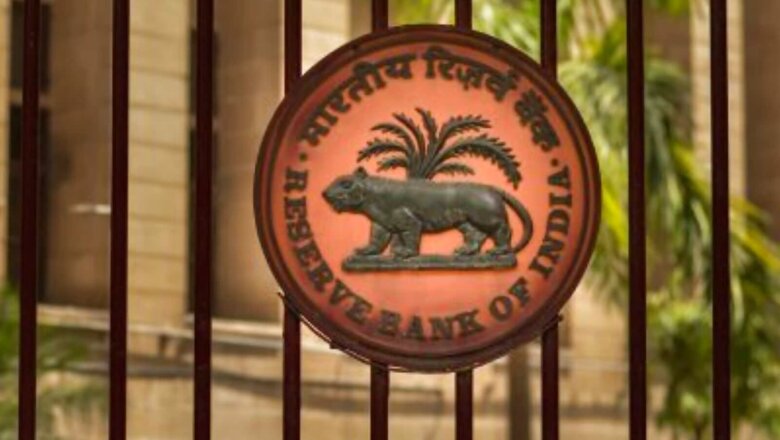
views
The Reserve Bank of India (RBI) on Friday revised downwards its GDP growth projection for the current financial year to 7.2 per cent, compared with the 7.8 per cent forecast earlier. Its Governor Shaktikanta Das said “escalating geopolitical tensions have cast a shadow on our economic outlook”.
Presenting MPC’s first bi-monthly monetary policy statement for the financial year 2022-23, Das said, “The real GDP growth for 2022-23 is now projected at 7.2 per cent with Q1:2022-23 at 16.2 per cent; Q2 at 6.2 per cent; Q3 at 4.1 per cent; and Q4 at 4.0 per cent, assuming crude oil (Indian basket) at US$ 100 per barrel during 2022-23.”
Das said that since the previous meeting in February, the expected positive benefits of the ebbing Omicron wave have been offset by the sharp escalation in geopolitical tension amid the ongoing Russia-Ukraine war. He added that this has affect domestic factors.
He said private consumption and fixed investment, the key drivers of domestic demand, remain subdued with these two components being only 1.2 per cent and 2.6 per cent respectively, above their pre-pandemic levels. On the supply side, contact-intensive services still trail the 2019-20 level. “Nevertheless, the Indian economy is steadily reviving from its pandemic-induced contraction.”
Das added, “During 2021-22, weakness in economic activity resurfaced in Q3 and got exacerbated by the emergence of the Omicron variant in January 2022. A gradual turnaround has been noticed during February, although in March 2022 a mixed picture was seen.”
Several high-frequency indicators such as railway freight, GST collections, toll collections, electricity demand, fuel consumption; and the imports of capital goods posted robust year-on-year expansion during February and March. With the easing of restrictions, domestic air passenger traffic rebounded in March.
According to the RBI’s surveys, consumer confidence also is improving and households’ optimism in outlook for the year ahead has strengthened with an uptick in sentiments
Das said robust rabi output should support recovery in rural demand, while a pick-up in contact-intensive services should help in further strengthening urban demand. “Investment activity may gain traction with improving business confidence, pick up in bank credit, continuing support from government capex and congenial financial conditions.”
Capacity utilisation (CU) in the manufacturing sector recovered further to 72.4 per cent in the third quarter of 2021-22 from 68.3 per cent in the previous quarter, surpassing the pre-pandemic level of 69.9 per cent in the fourth quarter of 2019-20.
The growth projections have been made considering the crude oil prices at USD 100 per barrel for the current financial year. In a press conference, Das said the supply of crude oil, natural gas, commodities, palladium has been affected due to the Russia-Ukraine war.
The Monetary Policy Committee (MPC) in its policy announcement on Friday maintained status quo on the repo rate to keep it at 4 per cent. It also maintained ‘accommodative’ stance, with focus on the withdrawal of this stance if inflation remains out of comfort zone.
Ramesh Nair, CEO, Colliers India and Managing Director, Market Development, Asia, Colliers: “The Indian economy appears to be well placed to withstand the shock supported by its forex reserves and stable financial sector. From a real estate perspective, the unchanged repo rate will continue to provide elbowroom to homebuyers, since home loan rates are at a record low. The housing sector saw a revival in 2021 and the continued low home loan rates can further propel homebuyers’ sentiments. The RBI hiked its reverse repo rate, which was expected due to inflationary tendencies seen in the economy.”
In the previous policy announcement in early February, the RBI had projected the real GDP growth is projected at 7.8 per cent for 2022-23, with the first quarter at 17.2 per cent; second quarter at 7 per cent; third quarter at 4.3 per cent; and fourth quarter at 4.5 per cent.
It had said, “In India, real GDP growth at 9.2 per cent for 2021-22 takes it modestly above the level of GDP in 2019-20.”
Since its last policy, multiple rating agencies have revised downwards their growth forecast on India amid elevated commodity prices and fresh supply chain issues arising from the Russia-Ukraine conflict. The agencies have also taken into account the downside risks arising from fresh lockdown in parts of China led by a surge in COVID-19 cases.
ICRA has revised downwards India’s GDP (gross domestic product) growth forecast for the current financial year 2022-23 to 7.2 per cent from an earlier projection of 8 per cent. India Ratings now projects India’s GDP growth for the current financial year 2022-23 at 7-7.2 per cent, from its earlier estimate of 7.6 per cent. Moody’s Investors Service has also lowered the country’s GDP growth forecast for 2022 to 9.1 per cent, from the earlier estimated 9.5 per cent. FICCI expects the GDP to grow 7.4 per cent this financial year.
Read all the Latest Business News and Breaking News here




















Comments
0 comment